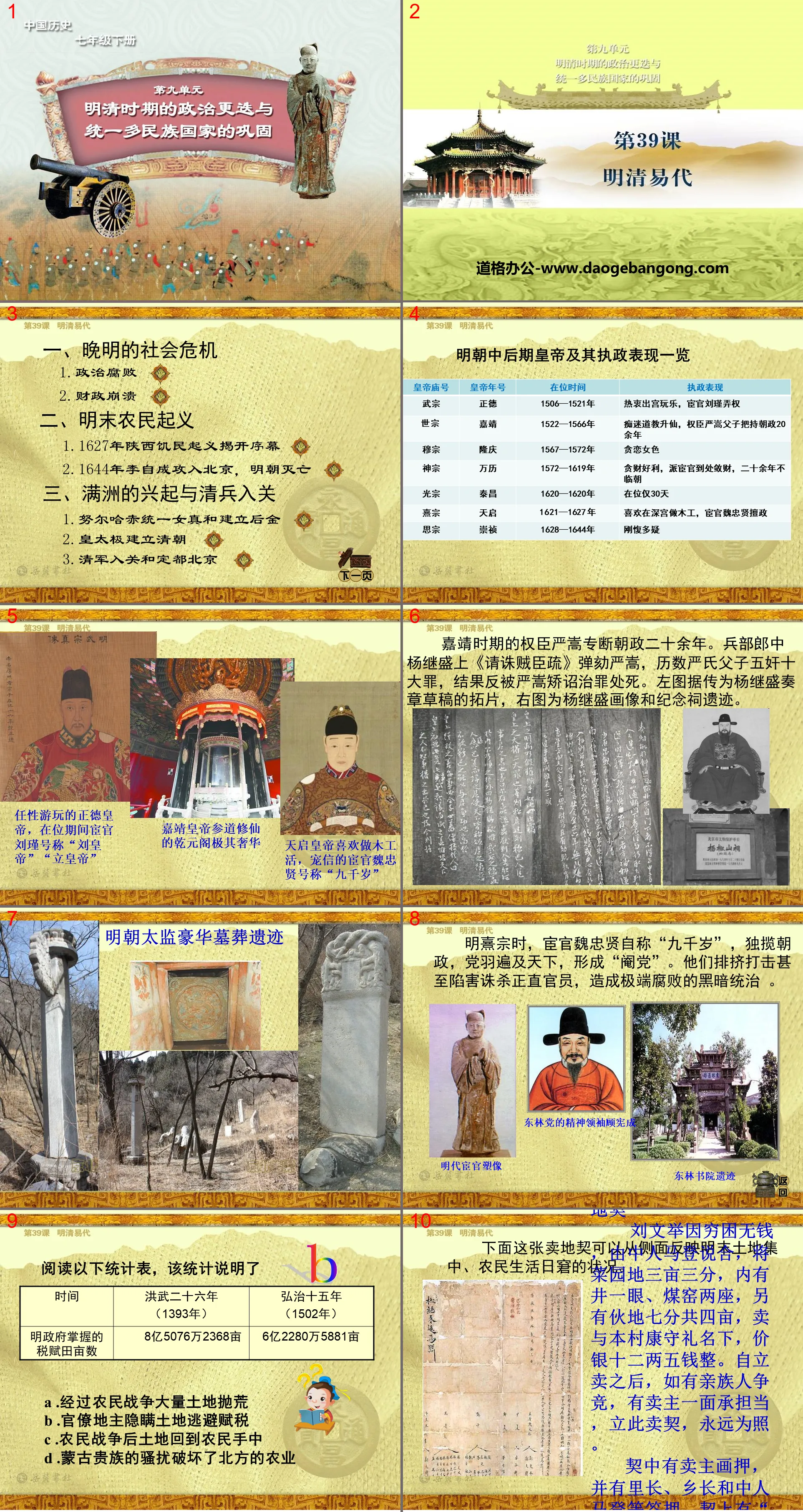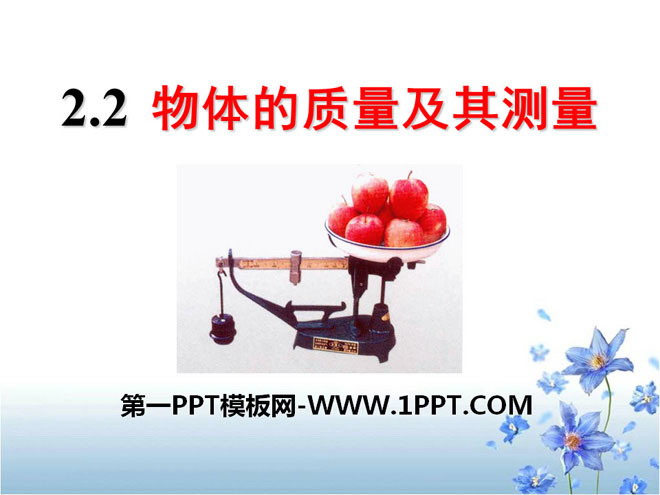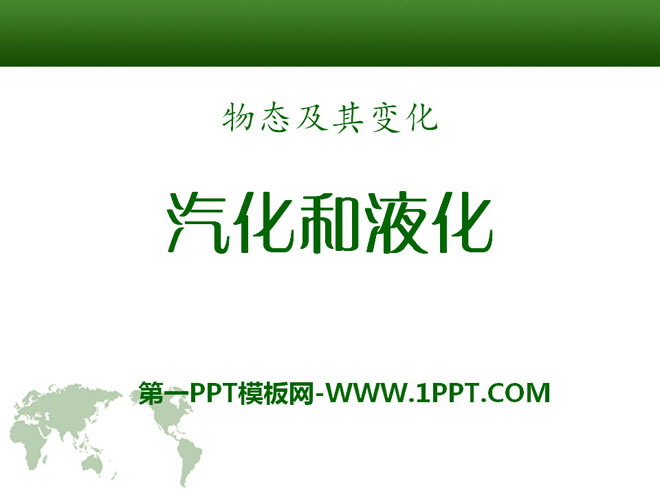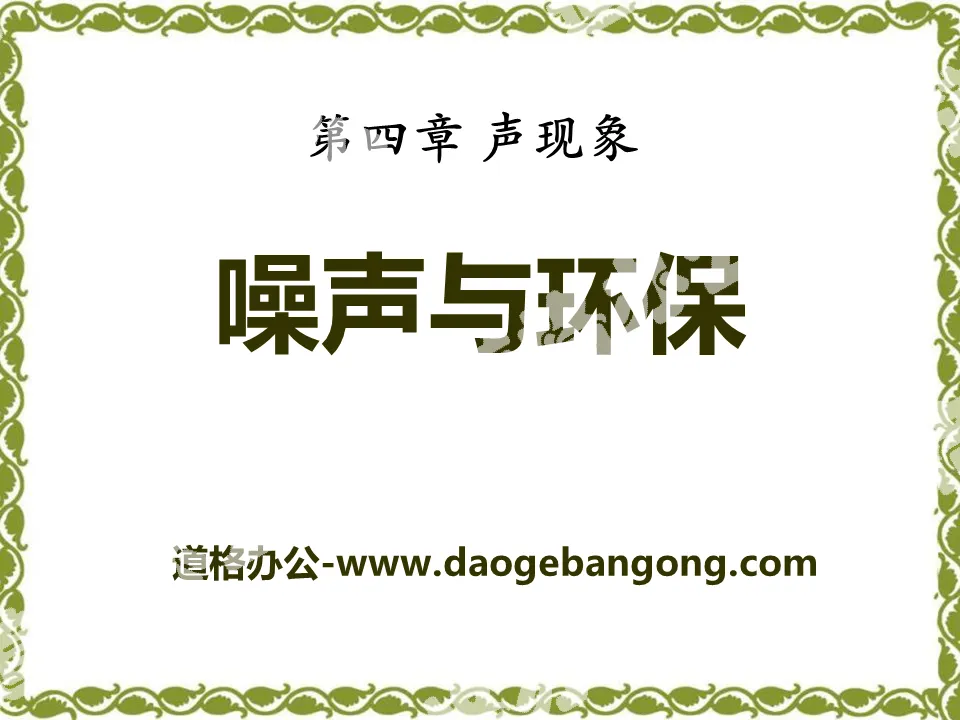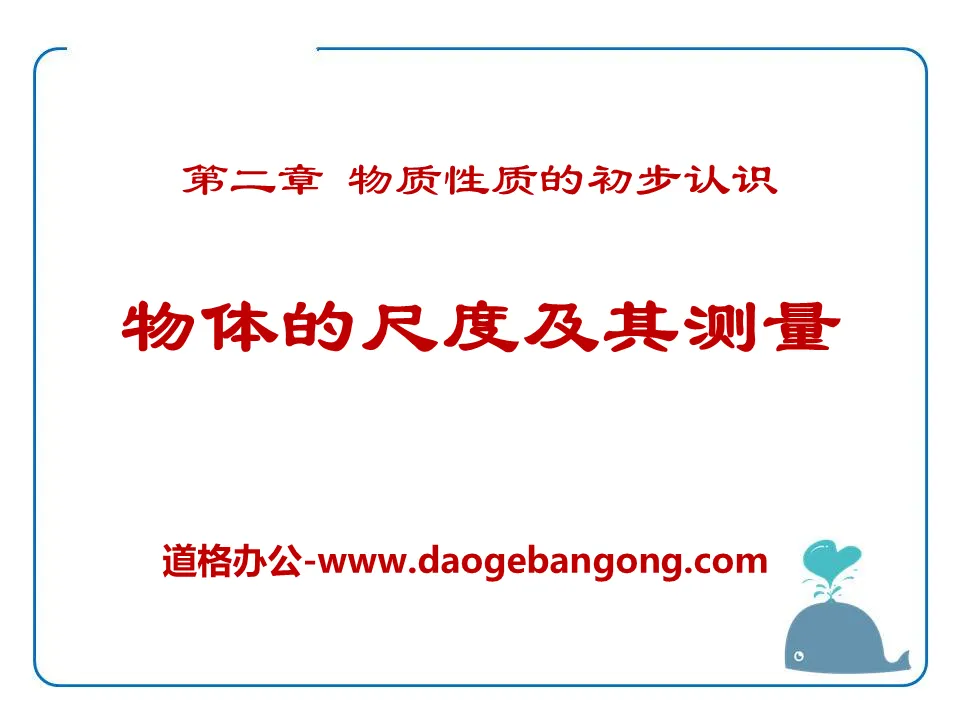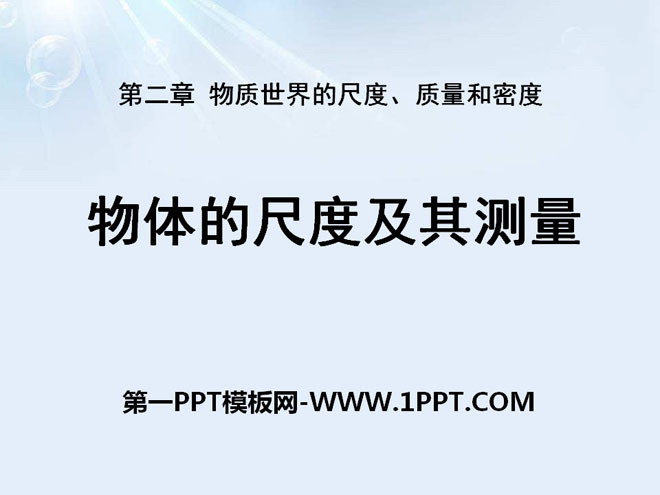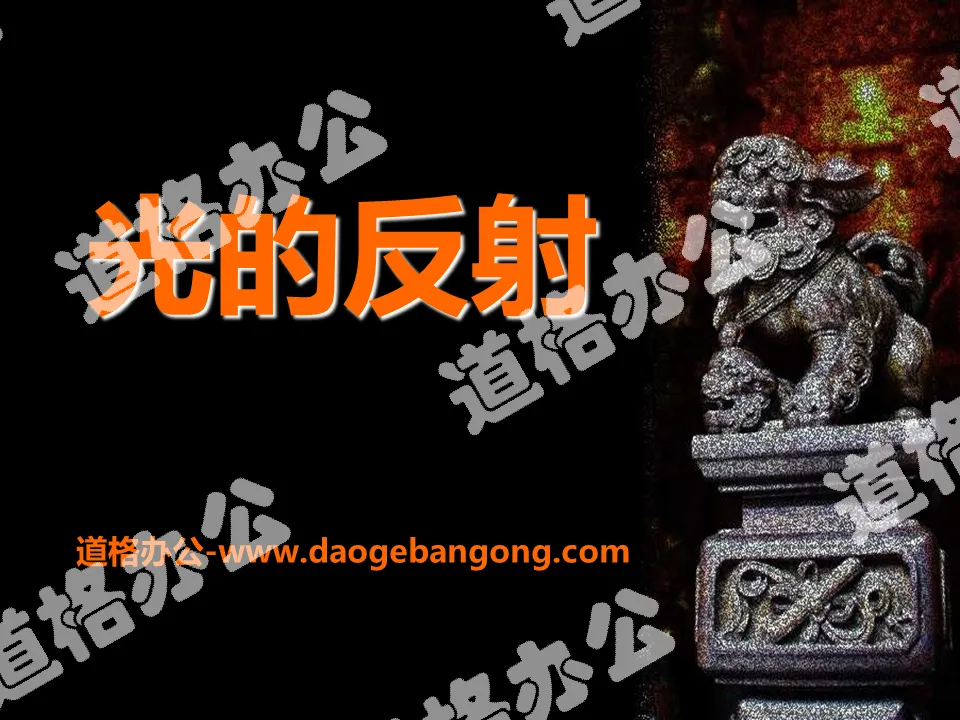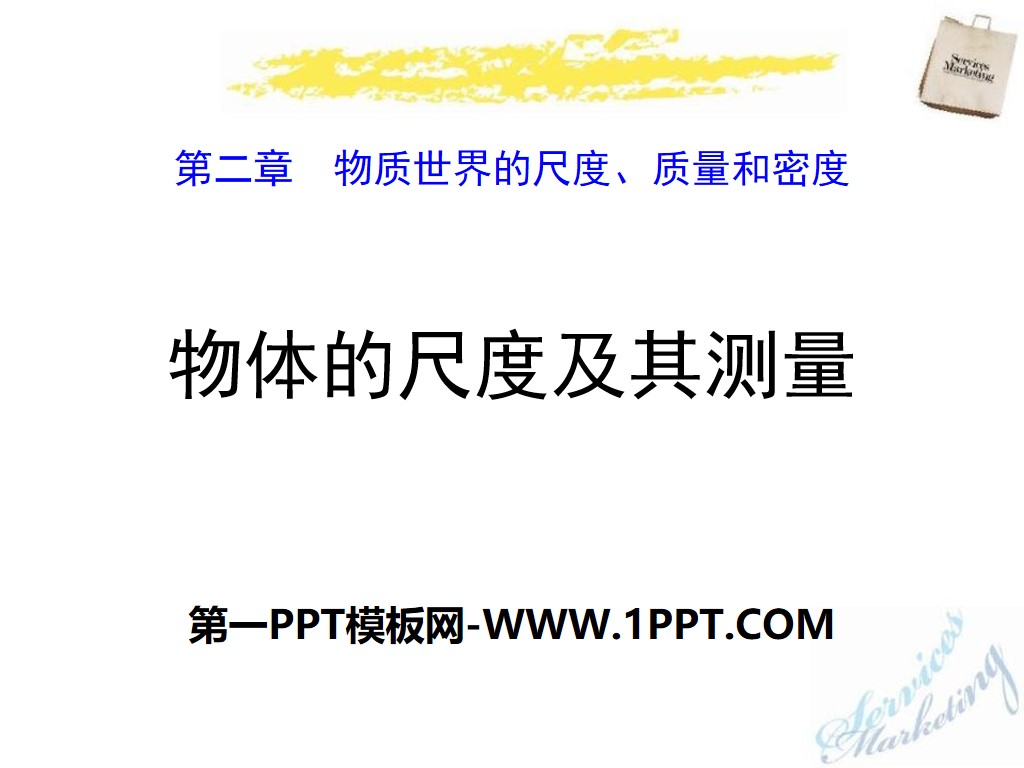
| Category | Format | Size |
|---|---|---|
| Yuelu Edition Seventh Grade History Volume 2 | pptx | 6 MB |
Description
"The Ming and Qing Dynasties" Political changes in the Ming and Qing Dynasties and the consolidation of a unified multi-ethnic country PPT courseware 2
1. Social crisis in the late Ming Dynasty
1. Political corruption
2. Fiscal collapse
2. Peasant uprising in the late Ming Dynasty
1.1627 Shaanxi Hungry People’s Uprising Begins
2. In 1644, Li Zicheng invaded Beijing and the Ming Dynasty fell.
3. The rise of Manchuria and the entry of Qing troops
1. Nurhaci unified the Jurchens and established the Later Jin Dynasty
2. Huang Taiji established the Qing Dynasty
3. The Qing army entered the customs and settled Beijing as the capital
The land sale deed below can reflect from the side the situation of land concentration and farmers' living embarrassment in the late Ming Dynasty.
A land sale deed from the Chongzhen period of the Ming Dynasty
Liu Wenju was poor and had no money, so he negotiated with Ma Deng, a middle-aged man, and sold the three-acre vegetable garden land to one-third of the land, which contained a well and two coal kilns, and seven-quarters of the farmland, totaling four acres, and sold it to Kang Shouli of his village for ten silver dollars. Two taels and five cents. After the sale is established, if there is any dispute among relatives, the seller will bear the responsibility and establish this sale deed, which will be in effect forever.
The deed was signed by the seller and signed by the village chief, township chief and middleman Ma Deng. There was a red stamp on the deed that said "materials have been raised and tax payment has been completed", which means it has been officially approved.
1. Social crisis in the late Ming Dynasty
Reasons: 1. Politics is becoming increasingly corrupt
2. Serious land annexation
3. Financial crisis
4. Social conflicts are acute
Peasant Revolt in the Late Ming Dynasty
What was the reason for the peasant uprising in the late Ming Dynasty?
(1) In the last years of the Ming Dynasty, political corruption became more and more serious, the country was in deep financial crisis, the court continued to increase taxes, the people were overwhelmed, and there were complaints and class conflicts were extremely sharp. Royal nobles, eunuchs, bureaucrats, landlords, etc. frantically annexed land and arbitrarily occupied farmland, resulting in the displacement of a large number of farmers.
(2) There has been severe drought in northern Shaanxi for several years, with no crops harvested and hungry people everywhere. The government did not care about the life and death of the people and continued to press for taxes. The vast number of farmers who were suffering from the disaster could no longer endure it and launched uprisings one after another.
1. Politics is becoming increasingly corrupt
2. Serious land annexation
3. Financial crisis
4. Social conflicts are acute
5. Natural disaster occurs
Leader: Li Zicheng, in 1636, was elected as the "King of Chuang"
Slogan: "Equal land without tax"
Establishing political power: In 1644, Li Zicheng established the Dashun regime in Xi'an
The Ming Dynasty was destroyed: In 1644, Li Zicheng led his army to invade Beijing; Emperor Chongzhen hanged himself on Meishan, and the Ming Dynasty was destroyed.
"Equal land and no tax"
"Kill the cattle and sheep, prepare wine, and open the city gate to welcome King Chuang. But King Chuang will not pay you food when he comes."
The slogan "equal land and no tax" pointed the finger at the serious land annexation phenomenon in the late Ming Dynasty.
It reflected the urgent desire of the majority of farmers to obtain land and reduce taxes, and greatly stimulated the farmers' revolutionary enthusiasm.
Research point: The rise of Manchuria and the entry of Qing troops into the country
Jurchen traceability:
Su Shen - Black Water - Jurchen - Manchuria
(Shang and Zhou Dynasties - Sui and Tang Dynasties - Northern Song Dynasty - Ming and Qing Dynasties)
The historical changes of the Jurchen tribe
1. The Jurchen tribe was called the �� tribe (Heishui, Sumo) in the Tang Dynasty, and was called the Jurchen tribe in the Song and Liao Dynasties.
2. In 1125 and 1127, the Jurchens headed by Wanyanbu established the Jin Dynasty under the leadership of Aguda, which destroyed the Liao and Northern Song Dynasties respectively.
3. In 1234, Mongolia destroyed the Jin Dynasty. The Jurchens who settled in the Yellow River Basin merged with the Han people and were regarded as "Han people" in the Yuan Dynasty.
4. In the early Ming Dynasty, the Northeastern Jurchens returned to Nurgandu. In the late Ming Dynasty, the Jurchen leader Nurhaci unified the various tribes.
What are Nurhachi's main achievements?
1. Unify all Jurchen tribes and form Manchu
2. Houjin was established in 1616
3. In 1618, he rebelled against the Ming Dynasty
What are Huang Taiji's main achievements?
1. In 1636, the country’s name was changed to Qing
2.Occupied the territory outside the Pass in 1643
Consolidation exercises
1. The Peasant War in the late Ming Dynasty pushed the level of Chinese Peasant War struggle to a new height because ( )
A. Li Zicheng's rebellion overthrew the Ming Dynasty
B. Li Zicheng's rebel army had a very wide range of activities
C. Li Zicheng's rebel army proposed equalizing land and exempting them from taxes
D. Li Zicheng's rebel army established peasant power
2. Li Zicheng’s slogan of “equalizing land and eliminating taxes” was put forward in response to which of the following situations in the late Ming Dynasty ( )
①High concentration of land ②Heavy military service ③Heavy taxes ④Expensive
A. ①②③ B. ③④ C. ②④ D.①③
3. The unified dynasty was repeatedly overthrown by peasant uprisings, which repeatedly confirmed the "metaphor of the boat and water". Late Qin and late Ming
What the peasant uprisings have in common is ( )
A. With folk religion as the organizational form B. With the characteristics of opposing national oppression
C. Raising troops to oppose tyranny D. Calling for equality with slogans
4. A folk song in the late Ming Dynasty goes: "Kill the cattle and sheep, prepare wine, and open the city gate to welcome King Chuang. When King Chuang comes, he will not pay for the food."
What kind of strong desire does this reflect of the peasant masses? ( )
A. Opposing property inequality and demanding access to land
B. Overthrow the authoritarian rulers
C. Carry out bourgeois revolution
D. Carry out socialist revolution
5. Which of the following statements about the reasons why the Qing Dynasty replaced the Ming Dynasty is correct ( )
①The Qing Dynasty is the representative of the emerging advanced power ②The ruling group in the late Ming Dynasty was extremely corrupt
③Wu Sangui introduced Qing troops into the customs, which led to a reversal of the military situation. ④The Qing army's combat effectiveness was stronger than that of the Ming army and the peasant army.
A.①③ B.②④ C.①④ D.②③
Keywords: Political changes during the Ming and Qing Dynasties and the consolidation of the unified multi-ethnic country teaching courseware, Ming and Qing Dynasty teaching courseware, Yuelu Edition seventh grade history volume 2 PPT courseware download, seventh grade history slide courseware download, Ming and Qing Dynasties Political change and the consolidation of a unified multi-ethnic country PPT courseware download, Ming and Qing dynasties PPT courseware download, .PPT format;
For more information about the PPT courseware "Political Changes in the Ming and Qing Dynasties and the Consolidation of a Unified Multi-Ethnic Country in the Ming and Qing Dynasties", please click on the "Political Changes in the Ming and Qing Dynasties and the Consolidation of a Unified Multi-Ethnic Country in the Ming and Qing Dynasties ppt" tag.
"Ming and Qing Dynasties" Political changes in the Ming and Qing Dynasties and the consolidation of a unified multi-ethnic country PPT courseware 4:
"The Ming and Qing Dynasties" Political changes in the Ming and Qing dynasties and the consolidation of a unified multi-ethnic country PPT courseware 4 The increasingly corrupt politics of the middle and late Ming Dynasty Ministers: 1. The emperor and the royal family: political corruption and social unrest Indulge in pleasure and neglect government affairs, ministers Forming parties for personal gain and fighting for power and profit. two..
"Ming and Qing Dynasties" Political changes during the Ming and Qing Dynasties and the consolidation of a unified multi-ethnic country PPT courseware 3:
"Ming and Qing Dynasties" Political changes in the Ming and Qing Dynasties and the consolidation of a unified multi-ethnic country PPT courseware 3 Introducing the new lesson Jurchen traceability: Su Shen Heishui - Jurchen Manchuria (Shang, Zhou, Sui, Tang, Northern Song, Ming and Qing) Historical changes of the Jurchen 1. The Jurchen tribe was called the �� tribe (..
"Ming and Qing Dynasties" Political changes in the Ming and Qing Dynasties and the consolidation of a unified multi-ethnic country PPT courseware:
"Ming and Qing Dynasties" Political changes in the Ming and Qing dynasties and the consolidation of a unified multi-ethnic country PPT courseware 1. Social crisis in the late Ming Dynasty 1. Political corruption: Most of the emperors in the middle and late Ming Dynasty ignored the government affairs _____ wielded power and courtiers formed parties to fight for power and profit. Politics is becoming increasingly corrupt. 2.Production destruction..
File Info
Update Time: 2024-07-29
This template belongs to History courseware Yuelu Edition Seventh Grade History Volume 2 industry PPT template
"The Ming and Qing Dynasties" Political changes in the Ming and Qing Dynasties and the consolidation of a unified multi-ethnic country PPT courseware 2 Simple campus recruitment activity planning plan summary enterprise and institution recruitment publicity lecture PPT template is a general PPT template for business post competition provided by the manuscript PPT, simple campus recruitment activity planning plan summary enterprise and institution recruitment promotion Lecture PPT template, you can edit and modify the text and pictures in the source file by downloading the source file. If you want more exquisite business PPT templates, you can come to grid resource. Doug resource PPT, massive PPT template slide material download, we only make high-quality PPT templates!
Tips: If you open the template and feel that it is not suitable for all your needs, you can search for related content "The Ming and Qing Dynasties" Political changes in the Ming and Qing Dynasties and the consolidation of a unified multi-ethnic country PPT courseware 2 is enough.
How to use the Windows system template
Directly decompress the file and use it with office or wps
How to use the Mac system template
Directly decompress the file and use it Office or wps can be used
Related reading
For more detailed PPT-related tutorials and font tutorials, you can view: Click to see
How to create a high-quality technological sense PPT? 4 ways to share the bottom of the box
Notice
Do not download in WeChat, Zhihu, QQ, built-in browsers, please use mobile browsers to download! If you are a mobile phone user, please download it on your computer!
1. The manuscript PPT is only for study and reference, please delete it 24 hours after downloading.
2. If the resource involves your legitimate rights and interests, delete it immediately.
3. Contact information: service@daogebangong.com
"The Ming and Qing Dynasties" Political changes in the Ming and Qing Dynasties and the consolidation of a unified multi-ethnic country PPT courseware 2, due to usage restrictions, it is only for personal study and reference use. For commercial use, please go to the relevant official website for authorization.
(Personal non-commercial use refers to the use of this font to complete the display of personal works, including but not limited to the design of personal papers, resumes, etc.)
Preview
